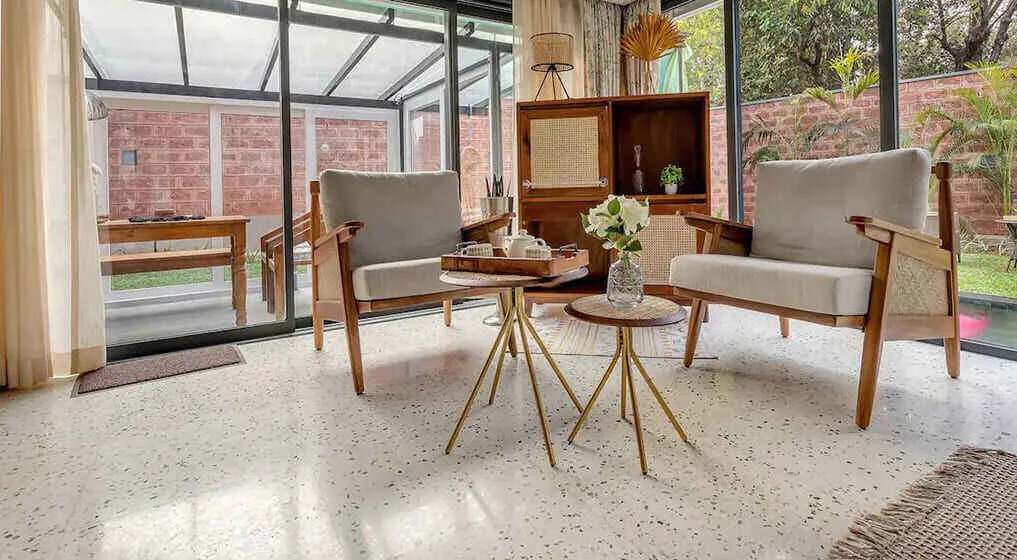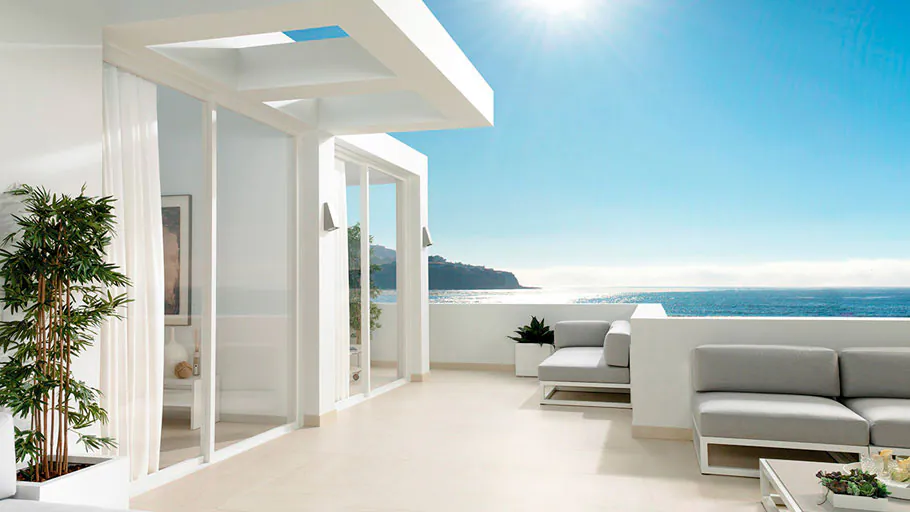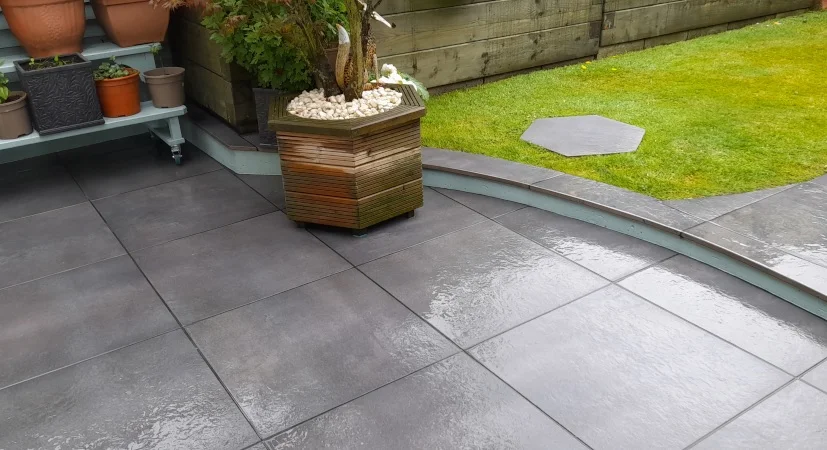However, when building or restructuring a house, most people pay attention to design, color schemes and budget. However, one important thing that can silently degrade your flooring’s lifetime and performance is your region’s climate. No matter what the climate is, there are different types of moisture, cold, heat and salt in the air that different climates come with. Being a cardinal part of your house, tiles must be selected not only for beauty, but also for the suitability of the tiles to your surroundings. So let us take a look at our local atmosphere and how it affects home construction and top tiles to work with depending on the climate.
Hot & Dry Regions (Deserts, Semi-Arid Zones, Interior Plains)
Where dry air, intense sunlight and differing temperatures between night and day prevail, as such, Southwestern parts of the USA, interior Australia, and the Middle East all expose homes to this. Heat resistance and natural cooling are common in the construction of these areas. They must not crack or fade under the influence of the sun for a long time. The flooring, in particular, plays a big role in maintaining indoor comfort. Tiles that absorb less heat and provide thermal insulation are a wise choice here.

What to Consider When Buying Tiles:
• Look for tiles with high heat resistance that do not expand or crack.
• Prefer light-colored tiles to reflect sunlight and maintain cooler interiors.
• Opt for low-maintenance finishes that are easy to clean and do not trap dust.
• Avoid highly polished tiles; they heat up faster and cause glare.
Recommended Tiles: Natural stone tiles such as slate and sandstone are recommended as they work well with the garden and remain cool underfoot. Breathable, traditional and aesthetically pleasing terracotta tiles also help to regulate indoor temperature. Porcelain tiles in matt finish for modern homes are readily available, are highly durable, and are practically maintenance-free in dusty conditions.
Humid & Rainy Regions (Tropical Areas, Coastal Hills, Monsoon Zones)
Regions like Kerala and Assam parts of Southeast Asia are noted to have high humidity and have rainy weather frequently. The air and surfaces are always damp here; thus, the most important consideration is the flooring that does not absorb or become slippery when water is present. In such climates, home construction will require waterproofing and ventilation. Mold-resistant walls and floors are mandatory, and the tile flooring should have a strong grip and be water-resistant.

What to Consider When Buying Tiles
• Ensure tiles have low water absorption (ideally vitrified or fully glazed).
• Choose anti-skid finishes, especially for bathrooms, balconies, and kitchens.
• Go for easy-to-clean surfaces to prevent mold or stains from moisture.
• Prefer dense, strong tiles that don’t warp or swell with prolonged humidity.
Recommended Tiles: In such a climate, recommended tiles are vitrified tiles because of their low porosity and greater water resistance. Anti-skid ceramic tiles possess both practicality as well as safety in bathrooms, kitchens, and entryways. Granite tiles come in a dense and durable variety that is ideal for use in moist conditions, and if properly sealed, they will hold up well under natural materials.
Coastal Areas (Sea-facing Towns, Beaches, and Islands)
Life near the coast, whether in Goa, Chennai, Mumbai, or international beach towns, comes with salty air, high humidity, and fine sand that inevitably finds its way indoors. Since these are homes that are located in areas that may be abraded by sand and saturated with moisture, they must be designed to resist corrosion and abrasion. Construction materials can get very salt-laden air, which can be surprisingly harsh on the floors so the flooring needs to be both easy to maintain and strong enough to handle everyday coastal wear and tear.

What to Consider When Buying Tiles:
• Choose salt-resistant, marine-grade tile coatings to prevent staining or corrosion.
• Look for textured surfaces that offer grip even when wet.
• Prefer tiles that are easy to mop and sweep, especially if sand is a daily guest.
• Avoid tiles with metallic elements or surfaces that degrade with salt exposure.
Recommended Tiles: Marine-grade glazed porcelain tiles are recommended due to their resistance to salt, stains, and weather-induced fading. A beachy look without being too scuffed and skippable is achieved with textured ceramic tiles on any outdoor decks or balconies. Want the laid-back wooden look without worrying about water damage? Go with wooden tile or vitrified wood-look tiles, which retain their stability in salty humid environments and are still warm and coastal.
Regions with All-Season Extremes (North India, Central Europe, American Midwest)
Delhi, Lucknow, or the regions of Europe and North America have all of them- hot summers, heavy monsoons and cold winters. Such a climate calls for flooring that still dries out when it rains, still expands and contracts without damaging them, still comfortable under their feet in heat and chill. Here, construction has to be flexible; thermal insulation, drainage systems and strong foundational materials that stand to seasonal shifts.

What to Consider When Buying Tiles
• Pick tiles that don’t crack with temperature changes, thermal stability is key.
• Choose tiles that feel comfortable underfoot, not too cold in winter.
• Opt for UV-resistant surfaces if tiles are exposed to sunlight.
• Ensure non-slip textures in outdoor areas where rain or frost may settle.
Recommended Tiles: Double-charged vitrified tiles are highly recommended as these are strong with temperature fluctuation facility. They are a perfect fit for high-traffic indoor areas. The use of porcelain tiles with wood-like textures helps to create warmth in winter and is also easy to maintain throughout the year. Textured exterior tiles can be used for balconies, pathways, terraces, or wherever you want texture, grip and weather resistance, no matter what season!
Skytouch Ceramic – The Largest Tile Manufacturer and Exporter
Skytouch Ceramic is a world-class leader when it comes to high-quality tiles, making specific tiles resistant to various climates and taking the modern living space to the next level. Skytouch Ceramic is a leading manufacturer and exporter of different wall and floor tiles, which are eminent due to advanced technology and sophisticated craftsmanship, while recognized as one of the biggest manufacturers of tiles. Skytouch is present with its strong base in over 59+ countries and an extensive range of the latest machinery manufacturing facility that adheres to quality, innovative designs, and eco-friendly production processes. Whether you're building in a hot desert, a coastal city, or a rainy tropical zone, Skytouch Ceramic offers tiles engineered for performance, beauty, and long-term durability.
Final Thoughts: Let Your Climate Guide Your Tile Choices
Every region comes with its own environmental demands, and your flooring should reflect that. Choosing the right tiles isn’t just about style or budget, it’s about ensuring comfort, safety, and durability in the long run. Whether you're designing a breezy beach house, a cozy hill station retreat, or a modern desert villa, the tile you choose should be in harmony with the atmosphere you live in. Build smart, live better right from the ground up.






